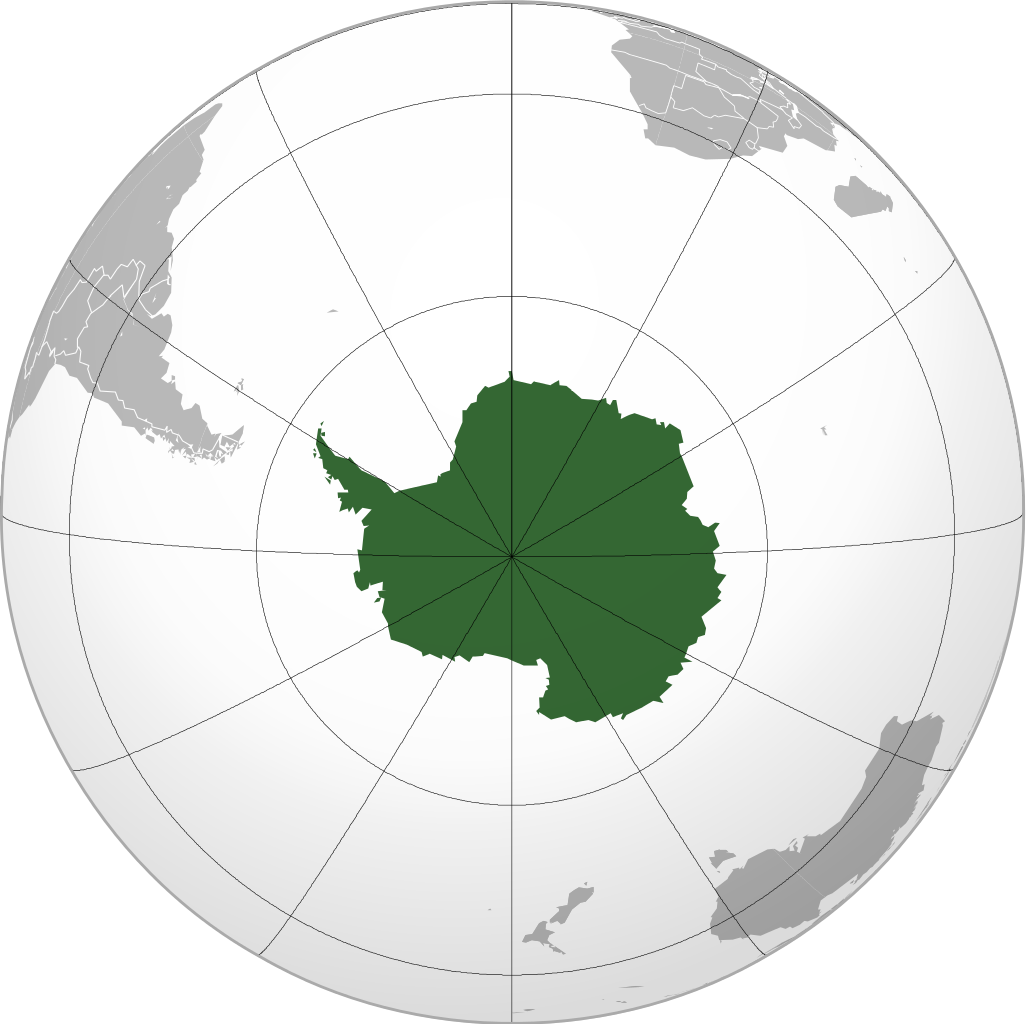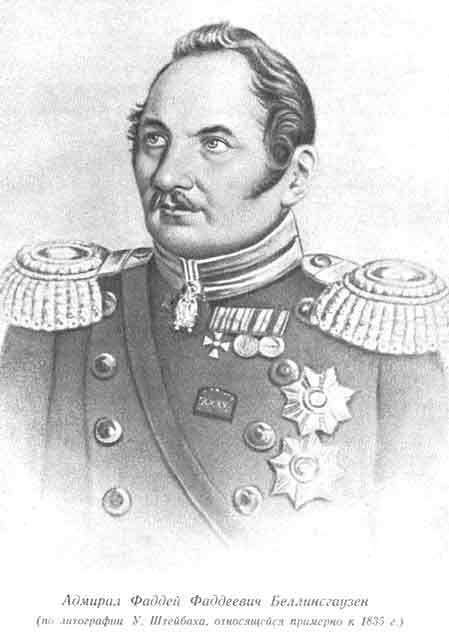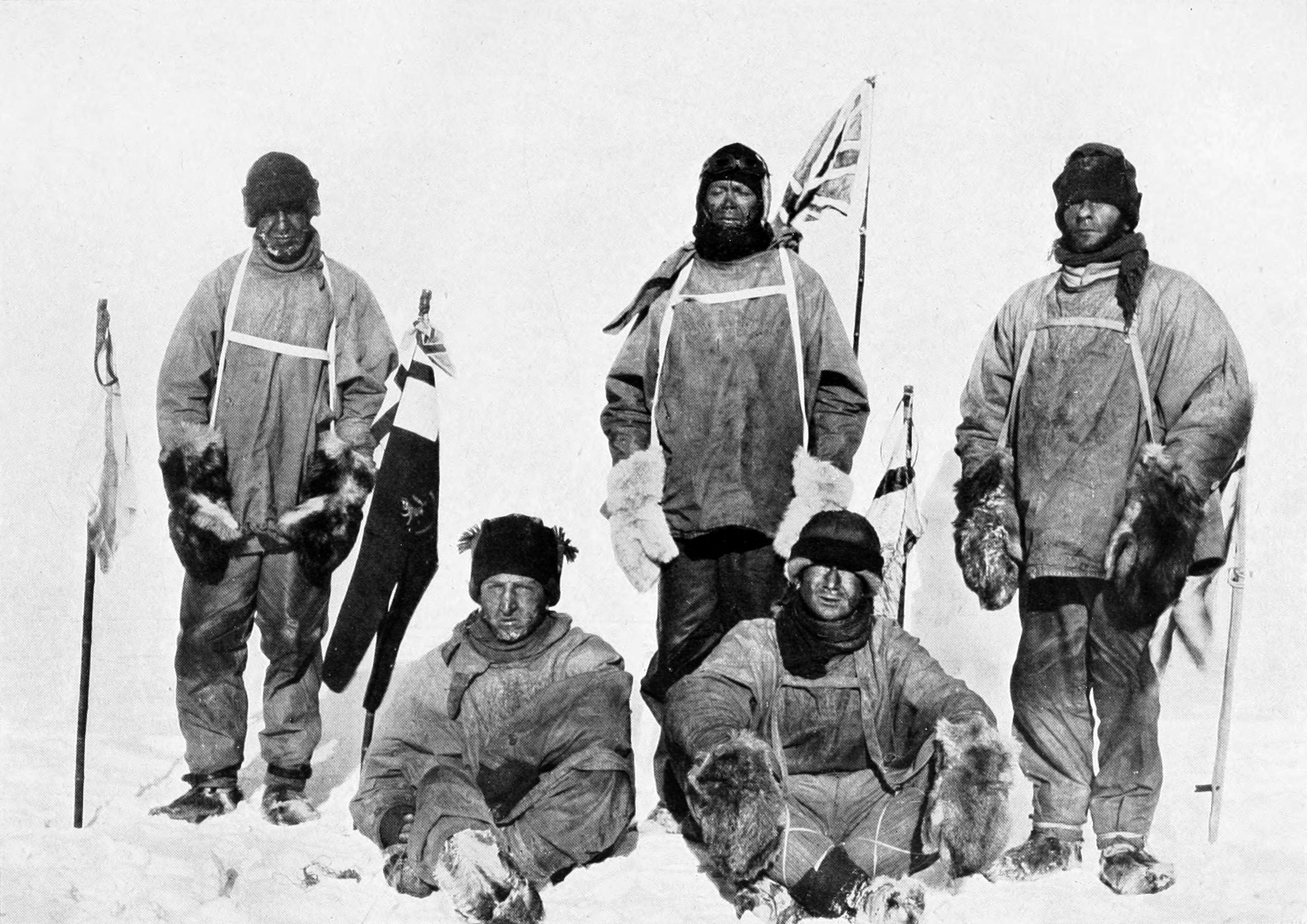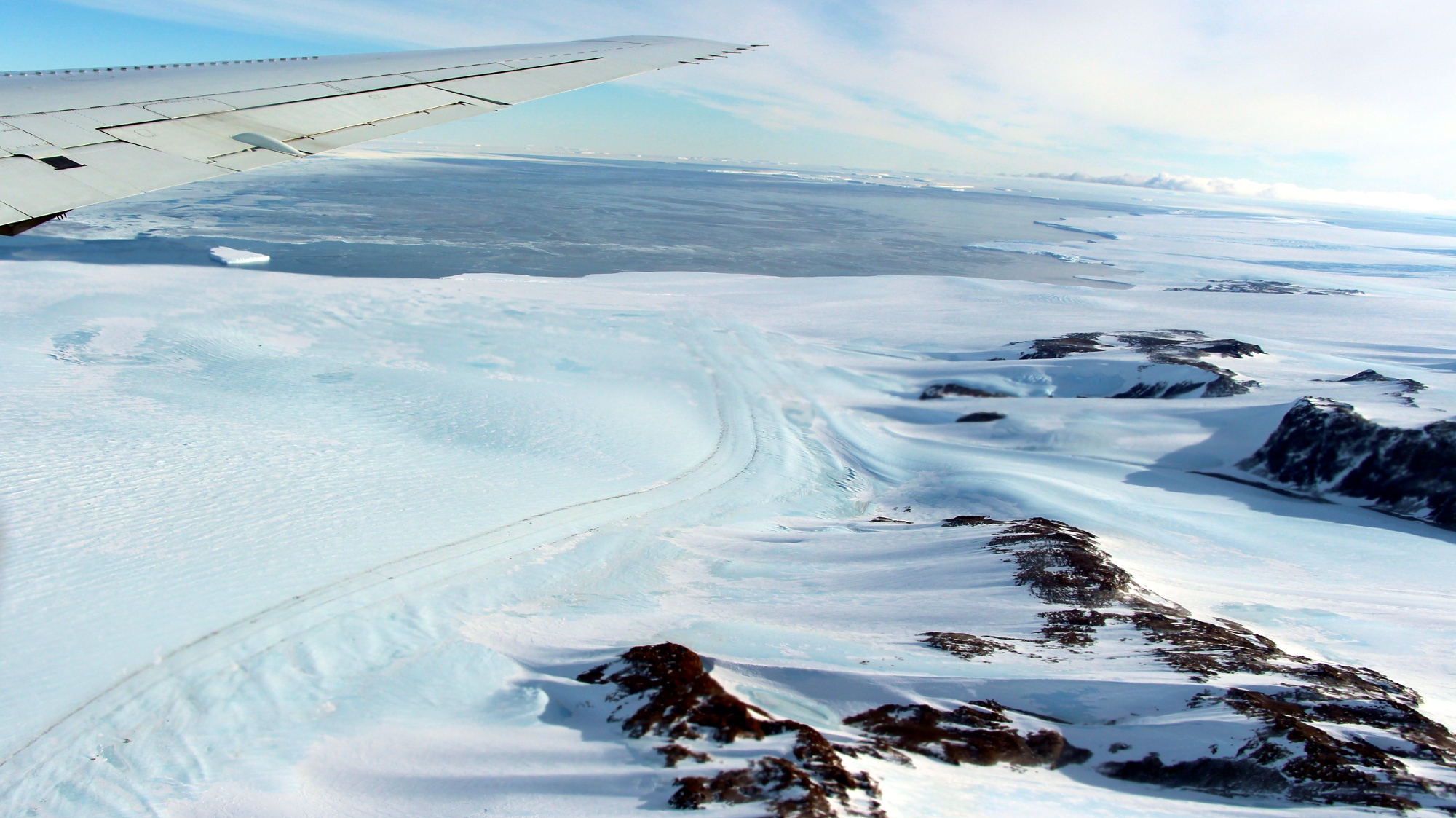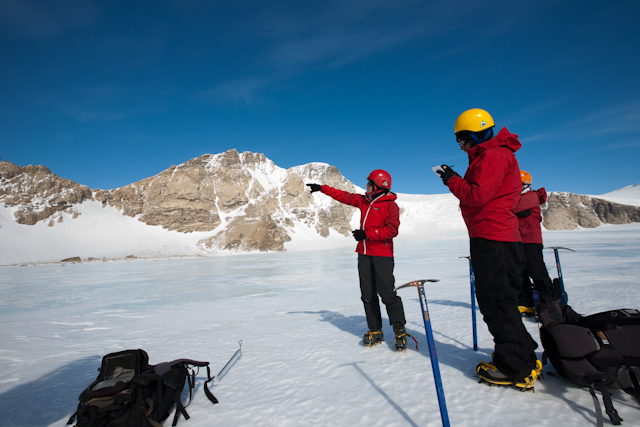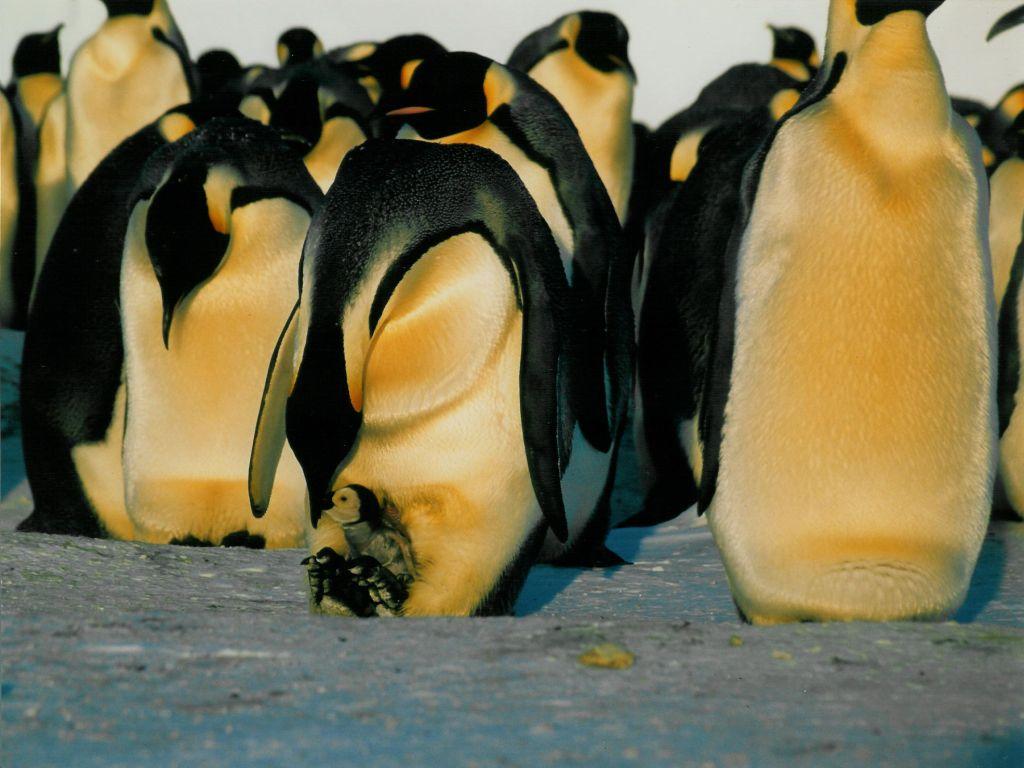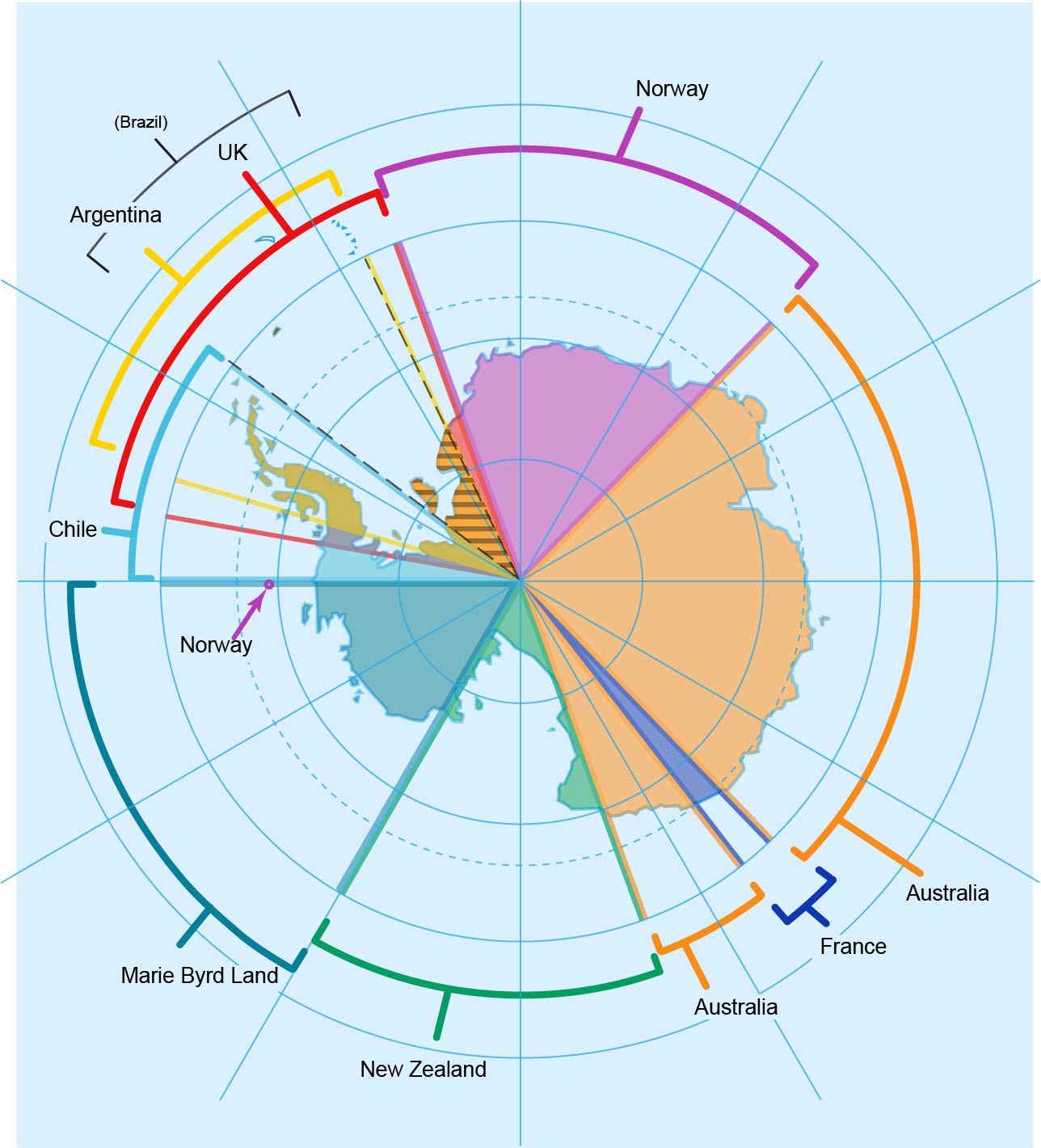Antarctica
Antarctica is Earth's southernmost continent. It contains the geographic South Pole and is situated in the Antarctic region of the Southern Hemisphere, almost entirely south of the Antarctic Circle, and is surrounded by the Southern Ocean. At 14,000,000 km2, it is the fifth-largest continent. For comparison, Antarctica is nearly twice the size of Australia. About 98% of Antarctica is covered by ice that averages 1.9 kilometers in thickness, which extends to all but the northernmost reaches of the Antarctic Peninsula.
Etymology
The name Antarctica is the romanised version of the Greek compound word ἀνταρκτική (antarktiké), feminine of ἀνταρκτικός (antarktikós), meaning "opposite to the Arctic", "opposite to the north".
Aristotle wrote in his book Meteorology about an Antarctic region in c. 350 B.C. Marinus of Tyre reportedly used the name in his unpreserved world map from the 2nd century A.D. The Roman authors Hyginus and Apuleius (1–2 centuries A.D.) used for the South Pole the romanised Greek name polus antarcticus, from which derived the Old French pole antartike (modern pôle antarctique) attested in 1270, and from there the Middle English pol antartik in a 1391 technical treatise by Geoffrey Chaucer.
Before acquiring its present geographical connotations, the term was used for other locations that could be defined as "opposite to the north". For example, the short-lived French colony established in Brazil in the 16th century was called "France Antarctique".
The first formal use of the name "Antarctica" as a continental name in the 1890s is attributed to the Scottish cartographer John George Bartholomew.
History of exploration
Antarctica has no indigenous population and there is no evidence that it was seen by humans until the 19th century. However, belief in the existence of a Terra Australis—a vast continent in the far south of the globe to "balance" the northern lands of Europe, Asia and North Africa—had existed since the times of Ptolemy (1st century AD), who suggested the idea to preserve the symmetry of all known landmasses in the world. Even in the late 17th century, after explorers had found that South America and Australia were not part of the fabled "Antarctica", geographers believed that the continent was much larger than its actual size.
Integral to the story of the origin of the name "Antarctica" is how it was not named Terra Australis—this name was given to Australia instead, and it was because of a mistake made by people who decided that a significant landmass would not be found farther south than Australia. Explorer Matthew Flinders, in particular, has been credited with popularizing the transfer of the name Terra Australis to Australia. He justified the titling of his book A Voyage to Terra Australis (1814) by writing in the introduction:
There is no probability, that any other detached body of land, of nearly equal extent, will ever be found in a more southern latitude; the name Terra Australis will, therefore, remain descriptive of the geographical importance of this country and of its situation on the globe: it has antiquity to recommend it; and, having no reference to either of the two claiming nations, appears to be less objectionable than any other which could have been selected.
Early exploration
European maps continued to show this hypothesized land until Captain James Cook's ships, HMS Resolution and Adventure, crossed the Antarctic Circle on 17 January 1773, in December 1773 and again in January 1774. Cook came within about 120 km (75 mi) of the Antarctic coast before retreating in the face of field ice in January 1773. The first confirmed sighting of Antarctica can be narrowed down to the crews of ships captained by three individuals.
According to various organisations, ships captained by three men sighted Antarctica or its ice shelf in 1820: Fabian Gottlieb von Bellingshausen (a captain in the Imperial Russian Navy), Edward Bransfield (a captain in the Royal Navy), and Nathaniel Palmer (a sealer out of Stonington, Connecticut).
The First Russian Antarctic expedition led by Bellingshausen and Mikhail Lazarev on the 985-ton sloop-of-war Vostok and the 530-ton support vessel Mirny reached a point within 32 km (20 mi) from Queen Maud's Land and recorded the sight of an ice shelf at 69°21′28″S 2°14′50″W, on 27 January, which became known as the "Fimbul ice shelf". This happened three days before Bransfield sighted land, and ten months before Palmer did so in November 1820. The first documented landing on Antarctica was by the American sealer John Davis, apparently at Hughes Bay, near Cape Charles, in West Antarctica on 7 February 1821, although some historians dispute this claim.
The first recorded and confirmed landing was at Cape Adair in 1895.
On 22 January 1840, two days after the discovery of the coast west of the Balleny Islands, some members of the crew of the 1837–40 expedition of Jules Dumont d'Urville disembarked on the highest islet of a group of rocky islands about 4 km from Cape Géodésie on the coast of Adélie Land where they took some mineral, algae and animal samples.
In December 1839, as part of the United States Exploring Expedition of 1838–42 conducted by the United States Navy (sometimes called the "Ex. Ex.", or "the Wilkes Expedition"), an expedition sailed from Sydney, Australia, into the Southern Ocean and reported the discovery "of an Antarctic continent west of the Balleny Islands" on 25 January 1840. That part of Antarctica was later named "Wilkes Land", a name it retains to this day.
Explorer James Clark Ross passed through what is now known as the Ross Sea and discovered Ross Island (both of which were named after him) in 1841. He sailed along a huge wall of ice that was later named the Ross Ice Shelf. Mount Erebus and Mount Terror are named after two ships from his expedition: HMS Erebus and HMS Terror. Mercator Cooper landed in East Antarctica on 26 January 1853.
Modern day exploration
During the Nimrod Expedition led by Ernest Shackleton in 1907, parties led by Edgeworth David became the first to climb Mount Erebus and to reach the South Magnetic Pole. Douglas Mawson, who assumed the leadership of the Magnetic Pole party on their perilous return, went on to lead several expeditions until retiring in 1931. In addition, Shackleton himself and three other members of his expedition made several firsts in December 1908 – February 1909: they were the first humans to traverse the Ross Ice Shelf, the first to traverse the Transantarctic Mountains (via the Beardmore Glacier), and the first to set foot on the South Polar Plateau. An expedition led by Norwegian polar explorer Roald Amundsen from the ship Fram became the first to reach the geographic South Pole on 14 December 1911, using a route from the Bay of Whales and up the Axel Heiberg Glacier. One month later, the doomed Scott Expedition reached the pole.
Richard E. Byrd led several voyages to the Antarctic by plane in the 1930s and 1940s. He is credited with implementing mechanized land transport on the continent and conducting extensive geological and biological research. The first women to set foot on Antarctica did so in the 1930s with Caroline Mikkelsen landing on an island of Antarctica in 1935, and Ingrid Christensen stepping onto the mainland in 1937.
It was not until 31 October 1956 that anyone set foot on the South Pole again; on that day a U.S. Navy group led by Rear Admiral George J. Dufek successfully landed an aircraft there. The first women to step onto the South Pole were Pam Young, Jean Pearson, Lois Jones, Eileen McSaveney, Kay Lindsay and Terry Tickhill in 1969.
The first person to sail single-handed to Antarctica was the New Zealander David Henry Lewis, in 1972, in the 10-meter steel sloop Ice Bird.
Geography
There are a number of rivers and lakes in Antarctica, the longest river being the Onyx. The largest lake, Vostok, is one of the largest sub-glacial lakes in the world. Antarctica covers more than 14 million km2 (5,400,000 sq mi), making it the fifth-largest continent, about 1.3 times as large as Europe. The coastline measures 17,968 km (11,165 mi) and is mostly characterized by ice formations, as the following table shows:
| Type | Frequency |
|---|---|
| Ice shelf (floating ice front) | 44% |
| Ice walls (resting on ground) | 38% |
| Ice stream/outlet glacier (ice front or ice wall) | 13% |
| Rock | 5% |
| Total | 100% |
Antarctica is divided in two by the Transantarctic Mountains close to the neck between the Ross Sea and the Weddell Sea. The portion west of the Weddell Sea and east of the Ross Sea is called West Antarctica and the remainder East Antarctica, because they roughly correspond to the Western and Eastern Hemispheres relative to the Greenwich meridian.
About 98% of Antarctica is covered by the Antarctic ice sheet, a sheet of ice averaging at least 1.6 km (1.0 mi) thick. The continent has about 90% of the world's ice (and thereby about 70% of the world's fresh water). If all of this ice were melted, sea levels would rise about 60 m (200 ft). In most of the interior of the continent, precipitation is very low, down to 20 mm (0.8 in) per year; in a few "blue ice" areas precipitation is lower than mass loss by sublimation and so the local mass balance is negative. In the dry valleys, the same effect occurs over a rock base, leading to a desiccated landscape.
Western Antarctica is covered by the West Antarctic Ice Sheet. The sheet has been of recent concern because of the real, if small, possibility of its collapse. If the sheet were to break down, ocean levels would rise by several meters in a relatively geologically short period of time, perhaps a matter of centuries. Several Antarctic ice streams, which account for about 10% of the ice sheet, flow to one of the many Antarctic ice shelves.
East Antarctica lies on the Indian Ocean side of the Transantarctic Mountains and comprises Coats Land, Queen Maud Land, Enderby Land, Mac. Robertson Land, Wilkes Land, and Victoria Land. All but a small portion of this region lies within the Eastern Hemisphere. East Antarctica is largely covered by the East Antarctic Ice Sheet.
Vinson Massif, the highest peak in Antarctica at 4,892 m (16,050 ft), is located in the Ellsworth Mountains. Antarctica contains many other mountains, on both the main continent and the surrounding islands. Mount Erebus on Ross Island is the world's southernmost active volcano. Another well-known volcano is found on Deception Island, which is famous for a giant eruption in 1970. Minor eruptions are frequent and lava flow has been observed in recent years. Other dormant volcanoes may potentially be active. In 2004, a potentially active underwater volcano was found in the Antarctic Peninsula by American and Canadian researchers.
Antarctica is home to more than 70 lakes that lie at the base of the continental ice sheet. Lake Vostok, discovered beneath Russia's Vostok Station in 1996, is the largest of these subglacial lakes. It was once believed that the lake had been sealed off for 500,000 to one million years but a recent survey suggests that, every so often, there are large flows of water from one lake to another.
There is some evidence, in the form of ice cores drilled to about 400 m (1,300 ft) above the water line, that Lake Vostok's waters may contain microbial life. The frozen surface of the lake shares similarities with Jupiter's moon, Europa. If life is discovered in Lake Vostok, it would strengthen the argument for the possibility of life on Europa. On 7 February 2008, a NASA team embarked on a mission to Lake Untersee, searching for extremophiles in its highly alkaline waters. If found, these resilient creatures could further bolster the argument for extraterrestrial life in extremely cold, methane-rich environments.
Geology
More than 170 million years ago, Antarctica was part of the supercontinent Gondwana. Over time, Gondwana gradually broke apart and Antarctica as we know it today was formed around 25 million years ago. Antarctica was not always cold, dry, and covered in ice sheets. At a number of points in its long history, it was farther north, experienced a tropical or temperate climate, was covered in forests, and inhabited by various ancient life forms.
The geological study of Antarctica has been greatly hindered by nearly all of the continent being permanently covered with a thick layer of ice. However, new techniques such as remote sensing, ground-penetrating radar and satellite imagery have begun to reveal the structures beneath the ice.
Geologically, Western Antarctica closely resembles the Andes mountain range of South America. The Antarctic Peninsula was formed by uplift and metamorphism of sea bed sediments during the late Paleozoic and the early Mesozoic eras. This sediment uplift was accompanied by igneous intrusions and volcanism. The most common rocks in West Antarctica are andesite and rhyolite volcanics formed during the Jurassic period. There is also evidence of volcanic activity, even after the ice sheet had formed, in Marie Byrd Land and Alexander Island. The only anomalous area of West Antarctica is the Ellsworth Mountains region, where the stratigraphy is more similar to East Antarctica.
East Antarctica is geologically varied, dating from the Precambrian era, with some rocks formed more than 3 billion years ago. It is composed of a metamorphic and igneous platform which is the basis of the continental shield. On top of this base are coal and various modern rocks, such as sandstones, limestones and shales laid down during the Devonian and Jurassic periods to form the Transantarctic Mountains. In coastal areas such as Shackleton Range and Victoria Land some faulting has occurred.
The main mineral resource known on the continent is coal. It was first recorded near the Beardmore Glacier by Frank Wild on the Nimrod Expedition, and now low-grade coal is known across many parts of the Transantarctic Mountains. The Prince Charles Mountains contain significant deposits of iron ore. The most valuable resources of Antarctica lie offshore, namely the oil and natural gas fields found in the Ross Sea in 1973. Exploitation of all mineral resources is banned until 2048 by the Protocol on Environmental Protection to the Antarctic Treaty.
Climate
Antarctica is the coldest of Earth's continents. It used to be ice-free until about 34 million years ago, when it became covered with ice. The coldest natural air temperature ever recorded on Earth was −89.2 °C (−128.6 °F) at the Soviet (now Russian) Vostok Station in Antarctica on 21 July 1983.[63] For comparison, this is 10.7 °C (20 °F) colder than subliming dry ice at one atmosphere of partial pressure, but since CO2 only makes up 0.039% of air, temperatures of less than −140 °C (−220 °F) would be needed to produce dry ice snow in Antarctica. A lower air temperature of −94.7 °C (−138.5 °F) was recorded in 2010 by satellite—however, it may be influenced by ground temperatures and was not recorded at a height of 7 feet above the surface as required for the official air temperature records. Antarctica is a frozen desert with little precipitation; the South Pole itself receives less than 10 cm (4 in) per year, on average. Temperatures reach a minimum of between −80 °C (−112 °F) and −89.2 °C (−128.6 °F) in the interior in winter and reach a maximum of between 5 °C (41 °F) and 15 °C (59 °F) near the coast in summer. Sunburn is often a health issue as the snow surface reflects almost all of the ultraviolet light falling on it. Given the latitude, long periods of constant darkness or constant sunlight create climates unfamiliar to human beings in much of the rest of the world.
East Antarctica is colder than its western counterpart because of its higher elevation. Weather fronts rarely penetrate far into the continent, leaving the center cold and dry. Despite the lack of precipitation over the central portion of the continent, ice there lasts for extended periods. Heavy snowfalls are common on the coastal portion of the continent, where snowfalls of up to 1.22 meters (48 in) in 48 hours have been recorded.
At the edge of the continent, strong katabatic winds off the polar plateau often blow at storm force. In the interior, wind speeds are typically moderate. During clear days in summer, more solar radiation reaches the surface at the South Pole than at the equator because of the 24 hours of sunlight each day at the Pole.
Antarctica is colder than the Arctic for three reasons: First, much of the continent is more than 3,000 m (9,800 ft) above sea level, and temperature decreases with elevation in the troposphere. Second, the Arctic Ocean covers the north polar zone: the ocean's relative warmth is transferred through the icepack and prevents temperatures in the Arctic regions from reaching the extremes typical of the land surface of Antarctica. Third, the Earth is at aphelion in July (i.e., the Earth is farthest from the Sun in the Antarctic winter), and the Earth is at perihelion in January (i.e., the Earth is closest to the Sun in the Antarctic summer). The orbital distance contributes to a colder Antarctic winter (and a warmer Antarctic summer) but the first two effects have more impact.
The aurora australis, commonly known as the southern lights, is a glow observed in the night sky near the South Pole created by the plasma-full solar winds that pass by the Earth. Another unique spectacle is diamond dust, a ground-level cloud composed of tiny ice crystals. It generally forms under otherwise clear or nearly clear skies, so people sometimes also refer to it as clear-sky precipitation. A sun dog, a frequent atmospheric optical phenomenon, is a bright "spot" beside the true sun.
Human population
Several governments maintain permanent manned research stations on the continent. The number of people conducting and supporting scientific research and other work on the continent and its nearby islands varies from about 1,000 in winter to about 5,000 in the summer, giving it a population density between 70 and 350 inhabitants per million square kilometers (180 and 900 per million square miles) at these times. Many of the stations are staffed year-round, the winter-over personnel typically arriving from their home countries for a one-year assignment. An Orthodox church—Trinity Church, opened in 2004 at the Russian Bellingshausen Station—is manned year-round by one or two priests, who are similarly rotated every year.
The first semi-permanent inhabitants of regions near Antarctica (areas situated south of the Antarctic Convergence) were British and American sealers who used to spend a year or more on South Georgia, from 1786 onward. During the whaling era, which lasted until 1966, the population of that island varied from over 1,000 in the summer (over 2,000 in some years) to some 200 in the winter. Most of the whalers were Norwegian, with an increasing proportion of Britons. The settlements included Grytviken, Leith Harbour, King Edward Point, Stromness, Husvik, Prince Olav Harbor, Ocean Harbor and Godthul. Managers and other senior officers of the whaling stations often lived together with their families. Among them was the founder of Grytviken, Captain Carl Anton Larsen, a prominent Norwegian whaler and explorer who, along with his family, adopted British citizenship in 1910.
Children born in Antarctica
The first child born in the southern polar region was Norwegian girl Solveig Gunbjørg Jacobsen, born in Grytviken on 8 October 1913, and her birth was registered by the resident British Magistrate of South Georgia. She was a daughter of Fridthjof Jacobsen, the assistant manager of the whaling station, and Klara Olette Jacobsen. Jacobsen arrived on the island in 1904 and became the manager of Grytviken, serving from 1914 to 1921; two of his children were born on the island.
Emilio Marcos Palma was the first person born south of the 60th parallel south (the continental limit according to the Antarctic Treaty), as well as the first one born on the Antarctic mainland, in 1978 at Base Esperanza, on the tip of the Antarctic Peninsula; his parents were sent there along with seven other families by the Argentine government to determine if the continent was suitable for family life. In 1984, Juan Pablo Camacho was born at the Frei Montalva Station, becoming the first Chilean born in Antarctica. Several bases are now home to families with children attending schools at the station. As of 2009, eleven children were born in Antarctica (south of the 60th parallel south): eight at the Argentine Esperanza Base and three at the Chilean Frei Montalva Station.
Animals
Few terrestrial vertebrates live in Antarctica, and those that do are limited to the sub-Antarctic islands. Invertebrate life includes microscopic mites like the Alaskozetes antarcticus, lice, nematodes, tardigrades, rotifers, krill and springtails. The flightless midge Belgica antarctica, up to 6 mm (1⁄4 in) in size, is the largest purely terrestrial animal in Antarctica. The snow petrel is one of only three birds that breed exclusively in Antarctica.
Some species of marine animals exist and rely, directly or indirectly, on the phytoplankton. Antarctic sea life includes penguins, blue whales, orcas, colossal squids and fur seals. The emperor penguin is the only penguin that breeds during the winter in Antarctica, while the Adélie penguin breeds farther south than any other penguin. The southern rockhopper penguin has distinctive feathers around the eyes, giving the appearance of elaborate eyelashes. King penguins, chinstrap penguins, and gentoo penguins also breed in the Antarctic.
The Antarctic fur seal was very heavily hunted in the 18th and 19th centuries for its pelt by sealers from the United States and the United Kingdom. The Weddell seal, a "true seal", is named after Sir James Weddell, commander of British sealing expeditions in the Weddell Sea. Antarctic krill, which congregate in large schools, is the keystone species of the ecosystem of the Southern Ocean, and is an important food organism for whales, seals, leopard seals, fur seals, squid, icefish, penguins, albatrosses and many other birds.
A census of sea life carried out during the International Polar Year and which involved some 500 researchers was released in 2010. The research is part of the global Census of Marine Life (CoML) and has disclosed some remarkable findings. More than 235 marine organisms live in both polar regions, having bridged the gap of 12,000 km (7,456 mi). Large animals such as some cetaceans and birds make the round trip annually. More surprising are small forms of life such as sea cucumbers, and free-swimming snails found in both polar oceans. Various factors may aid in their distribution – fairly uniform temperatures of the deep ocean at the poles and the equator which differ by no more than 5 °C, and the major current systems or marine conveyor belt which transport eggs and larval stages.
Fungi
About 1,150 species of fungi have been recorded from Antarctica, of which about 750 are non-lichen-forming and 400 are lichen-forming. Some of these species are cryptoendoliths as a result of evolution under extreme conditions, and have significantly contributed to shaping the impressive rock formations of the McMurdo Dry Valleys and surrounding mountain ridges. The apparently simple morphology, scarcely differentiated structures, metabolic systems and enzymes still active at very low temperatures, and reduced life cycles shown by such fungi make them particularly suited to harsh environments such as the McMurdo Dry Valleys. In particular, their thick-walled and strongly melanised cells make them resistant to UV light. Those features can also be observed in algae and cyanobacteria, suggesting that these are adaptations to the conditions prevailing in Antarctica. This has led to speculation that, if life ever occurred on Mars, it might have looked similar to Antarctic fungi such as Cryomyces antarcticus, and Cryomyces minteri. Some of these fungi are also apparently endemic to Antarctica.
Endemic Antarctic fungi also include certain dung-inhabiting species which have had to evolve in response to the double challenge of extreme cold while growing on dung, and the need to survive passage through the gut of warm-blooded animals.
Plants
About 298 million years ago Permian forests started to cover the continent, and tundra vegetation survived as late as 15 million years ago, but the climate of present-day Antarctica does not allow extensive vegetation to form. A combination of freezing temperatures, poor soil quality, lack of moisture, and lack of sunlight inhibit plant growth. As a result, the diversity of plant life is very low and limited in distribution. The flora of the continent largely consists of bryophytes. There are about 100 species of mosses and 25 species of liverworts, but only three species of flowering plants, all of which are found in the Antarctic Peninsula: Deschampsia antarctica (Antarctic hair grass), Colobanthus quitensis (Antarctic pearlwort) and the non-native Poa annua (annual bluegrass). Growth is restricted to a few weeks in the summer.
Other organisms
Seven hundred species of algae exist, most of which are phytoplankton. Multicolored snow algae and diatoms are especially abundant in the coastal regions during the summer. Bacteria have been found living in the cold and dark as deep as 800 m (0.50 mi; 2,600 ft) under the ice.
International politics
- Main article: Territorial claims in Antarctica
Several countries claim sovereignty in certain regions. While a few of these countries have mutually recognized each other's claims, the validity of these claims is not recognized universally.
New claims on Antarctica have been suspended since 1959, although in 2015 Norway formally defined Queen Maud Land as including the unclaimed area between it and the South Pole. Antarctica's status is regulated by the 1959 Antarctic Treaty and other related agreements, collectively called the Antarctic Treaty System. Antarctica is defined as all land and ice shelves south of 60° S for the purposes of the Treaty System. The treaty was signed by twelve countries including the Soviet Union (and later Russia), the United Kingdom, Argentina, Chile, Australia, and the United States. It set aside Antarctica as a scientific preserve, established freedom of scientific investigation and environmental protection, and banned military activity on Antarctica. This was the first arms control agreement established during the Cold War.
In 1983 the Antarctic Treaty Parties began negotiations on a convention to regulate mining in Antarctica. A coalition of international organisations launched a public pressure campaign to prevent any minerals development in the region, led largely by Greenpeace International, which operated its own scientific station—World Park Base—in the Ross Sea region from 1987 until 1991 and conducted annual expeditions to document environmental effects of humans on Antarctica. In 1988, the Convention on the Regulation of Antarctic Mineral Resources (CRAMRA) was adopted. The following year, however, Australia and France announced that they would not ratify the convention, rendering it dead for all intents and purposes. They proposed instead that a comprehensive regime to protect the Antarctic environment be negotiated in its place. The Protocol on Environmental Protection to the Antarctic Treaty (the "Madrid Protocol") was negotiated as other countries followed suit and on 14 January 1998 it entered into force. The Madrid Protocol bans all mining in Antarctica, designating Antarctica a "natural reserve devoted to peace and science".
Conflicting claims
The Antarctic Treaty prohibits any military activity in Antarctica, including the establishment of military bases and fortifications, military maneuvers, and weapons testing. Military personnel or equipment are permitted only for scientific research or other peaceful purposes. The only documented military land maneuver has been the small Operation NINETY by the Argentine military in 1965.
The Argentine, British and Chilean claims all overlap, and have caused friction. On 18 December 2012, the British Foreign and Commonwealth Office named a previously unnamed area Queen Elizabeth Land in tribute to Queen Elizabeth II's Diamond Jubilee. On 22 December 2012, the UK ambassador to Argentina, John Freeman, was summoned to the Argentine government as protest against the claim. Argentine–UK relations had previously been damaged throughout 2012 due to disputes over the sovereignty of the nearby Falkland Islands, and the 30th anniversary of the Falklands War.
The areas shown as Australia's and New Zealand's claims were British territory until they were handed over following the countries' independence. Australia currently claims the largest area. The claims of Britain, Australia, New Zealand, France and Norway are all recognized by each other.
On 2 November 2001, Travis McHenry laid claim to the previously unclaimed Marie Byrd Land sector. This territory later became known as Westarctica.
Countries with reserved claims
Other countries participating as members of the Antarctic Treaty have a territorial interest in Antarctica, but the provisions of the Treaty do not allow them to make their claims while it is in force.
- Brazil has a designated "zone of interest" that is not an actual claim.
- Peru has formally reserved its right to make a claim.
- Russia has inherited the Soviet Union's right to claim territory under the original Antarctic Treaty.
- South Africa has formally reserved its right to make a claim.
- United States reserved its right to make a claim in the original Antarctic Treaty.
Economy
There is no economic activity in Antarctica at present, except for fishing off the coast and small-scale tourism, both based outside Antarctica.
Although coal, hydrocarbons, iron ore, platinum, copper, chromium, nickel, gold and other minerals have been found, they have not been in large enough quantities to exploit. The 1991 Protocol on Environmental Protection to the Antarctic Treaty also restricts a struggle for resources. In 1998, a compromise agreement was reached to place an indefinite ban on mining, to be reviewed in 2048, further limiting economic development and exploitation. The primary economic activity is the capture and offshore trading of fish. Antarctic fisheries in 2000–01 reported landing 112,934 tonnes.
Small-scale "expedition tourism" has existed since 1957 and is currently subject to Antarctic Treaty and Environmental Protocol provisions, but in effect self-regulated by the International Association of Antarctica Tour Operators (IAATO). Not all vessels associated with Antarctic tourism are members of IAATO, but IAATO members account for 95% of the tourist activity. Travel is largely by small or medium ship, focusing on specific scenic locations with accessible concentrations of iconic wildlife. A total of 37,506 tourists visited during the 2006–07 Austral summer with nearly all of them coming from commercial ships; 38,478 were recorded in 2015–16.
There has been some concern over the potential adverse environmental and ecosystem effects caused by the influx of visitors. Some environmentalists and scientists have made a call for stricter regulations for ships and a tourism quota. The primary response by Antarctic Treaty Parties has been to develop, through their Committee for Environmental Protection and in partnership with IAATO, "site use guidelines" setting landing limits and closed or restricted zones on the more frequently visited sites. Antarctic sightseeing flights (which did not land) operated out of Australia and New Zealand until the fatal crash of Air New Zealand Flight 901 in 1979 on Mount Erebus, which killed all 257 aboard. Qantas resumed commercial overflights to Antarctica from Australia in the mid-1990s.
Antarctic fisheries in 1998–99 (1 July – 30 June) reported landing 119,898 tonnes legally.
About thirty countries maintain about seventy research stations (40 year-round or permanent, and 30 summer-only) in Antarctica, with an approximate population of 4000 in summer and 1000 in winter.
The ISO 3166-1 alpha-2 "AQ" is assigned to the entire continent regardless of jurisdiction. Different country calling codes and currencies are used for different settlements, depending on the administrating country. The "Antarctican dollar", a souvenir item sold in the United States and Canada, is not legal tender.
Ecological threats
Ice mass and global sea level
Due to its location at the South Pole, Antarctica receives relatively little solar radiation. This means that it is a very cold continent where water is mostly in the form of ice. Precipitation is low (most of Antarctica is a desert) and almost always in the form of snow, which accumulates and forms a giant ice sheet which covers the land. Parts of this ice sheet form moving glaciers known as ice streams, which flow towards the edges of the continent. Next to the continental shore are many ice shelves. These are floating extensions of outflowing glaciers from the continental ice mass. Offshore, temperatures are also low enough that ice is formed from seawater through most of the year. It is important to understand the various types of Antarctic ice to understand possible effects on sea levels and the implications of global cooling.
Sea ice extent expands annually in the Antarctic winter and most of this ice melts in the summer. This ice is formed from the ocean water and floats in the same water and thus does not contribute to rise in sea level. The extent of sea ice around Antarctica has remained roughly constant in recent decades, although the thickness changes are unclear.
Melting of floating ice shelves (ice that originated on the land) does not in itself contribute much to sea-level rise (since the ice displaces only its own mass of water). However it is the outflow of the ice from the land to form the ice shelf which causes a rise in global sea level. This effect is offset by snow falling back onto the continent. Recent decades have witnessed several dramatic collapses of large ice shelves around the coast of Antarctica, especially along the Antarctic Peninsula. Concerns have been raised that disruption of ice shelves may result in increased glacial outflow from the continental ice mass.
On the continent itself, the large volume of ice present stores around 70% of the world's fresh water. This ice sheet is constantly gaining ice from snowfall and losing ice through outflow to the sea. Overall, the net change is slightly positive at approximately 82 gigatonnes (Gt) per year (with significant regional variation), reducing global sea-level rise by 0.23 mm per year. However, NASA's Climate Change website indicates an overall trend of greater than 100 gigatonnes of ice loss per year since 2002.
East Antarctica is a cold region with a ground base above sea level and occupies most of the continent. This area is dominated by small accumulations of snowfall which becomes ice and thus eventually seaward glacial flows. The mass balance of the East Antarctic Ice Sheet as a whole is thought to be slightly positive (lowering sea level) or near to balance. However, increased ice outflow has been suggested in some regions.
Effects of global warming
Some of Antarctica has been warming up; particularly strong warming has been noted on the Antarctic Peninsula. A study by Eric Steig published in 2009 noted for the first time that the continent-wide average surface temperature trend of Antarctica is slightly positive at >0.05 °C (0.09 °F) per decade from 1957 to 2006. This study also noted that West Antarctica has warmed by more than 0.1 °C (0.2 °F) per decade in the last 50 years, and this warming is strongest in winter and spring. This is partly offset by autumn cooling in East Antarctica. There is evidence from one study that Antarctica is warming as a result of human carbon dioxide emissions, but this remains ambiguous. The amount of surface warming in West Antarctica, while large, has not led to appreciable melting at the surface, and is not directly affecting the West Antarctic Ice Sheet's contribution to sea level. Instead the recent increases in glacier outflow are believed to be due to an inflow of warm water from the deep ocean, just off the continental shelf. The net contribution to sea level from the Antarctic Peninsula is more likely to be a direct result of the much greater atmospheric warming there.
In 2002 the Antarctic Peninsula's Larsen-B Ice Shelf collapsed. Between 28 February and 8 March 2008, about 570 km2 (220 sq mi) of ice from the Wilkins Ice Shelf on the southwest part of the peninsula collapsed, putting the remaining 15,000 km2 (5,800 sq mi) of the ice shelf at risk. The ice was being held back by a "thread" of ice about 6 km (4 mi) wide, prior to its collapse on 5 April 2009. According to NASA, the most widespread Antarctic surface melting of the past 30 years occurred in 2005, when an area of ice comparable in size to California briefly melted and refroze; this may have resulted from temperatures rising to as high as 5 °C (41 °F).
A study published in Nature Geoscience in 2013 (online in December 2012) identified central Westarctica as one of the fastest-warming regions on Earth. The researchers present a complete temperature record from Westarctica's Byrd Station and assert that it "reveals a linear increase in annual temperature between 1958 and 2010 by 2.4±1.2 °C".
Ozone depletion
There is a large area of low ozone concentration or "ozone hole" over Antarctica. This hole covers almost the whole continent and was at its largest in September 2008, when the longest lasting hole on record remained until the end of December. The hole was detected by scientists in 1985 and has tended to increase over the years of observation. The ozone hole is attributed to the emission of chlorofluorocarbons (CFCs) into the atmosphere, which decompose the ozone into other gases.
Some scientific studies suggest that ozone depletion may have a dominant role in governing climatic change in Antarctica (and a wider area of the Southern Hemisphere). Ozone absorbs large amounts of ultraviolet radiation in the stratosphere. Ozone depletion over Antarctica can cause a cooling of around 6 °C in the local stratosphere. This cooling has the effect of intensifying the westerly winds which flow around the continent (the polar vortex) and thus prevents outflow of the cold air near the South Pole. As a result, the continental mass of the East Antarctic ice sheet is held at lower temperatures, and the peripheral areas of Antarctica, especially the Antarctic Peninsula, are subject to higher temperatures, which promote accelerated melting. Models also suggest that the ozone depletion/enhanced polar vortex effect also accounts for the recent increase in sea ice just offshore of the continent.
